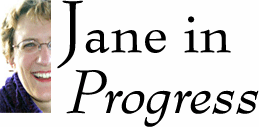 |
|
 |
 |
Looking for tips and tricks to the art of writing for television? Welcome to the blog of experienced television writer Jane Espenson. Check it out regularly to learn about spec scripts, writing dos and don'ts, and what Jane had for lunch! (RSS:  ) |
|
|
Home » Archives » August 2006 » Putting the Ka- Before the Boom
[Previous entry: "It's Craftastic!"] [Next entry: "The Crash of the Symbols"]
08/02/2006: Putting the Ka- Before the Boom
So, tonight after Project Runway -- the best show ever created -- I watched an episode of House. It was one that I seem to have missed during this last season. This one featured the gorgeous Mel Harris, whom I worked with on Something so Right, and the equally gorgeous Michelle Trachtenberg, whom I worked with on Buffy. I guess eventually I’ll have worked long enough that some episode of something will come on with an all Jane's career cast.
Anyway, I noticed something about one of the act breaks that I thought everyone should notice. Here's how it went. First, there was a lot of hinting around about 'paralysis,' but without really spelling out what it would mean for the patient. Finally, the mother said:
MOTHER
She's going to lose the use of her legs?
This was a pretty big moment. A bit of a thunderclap, since it hadn’t really been clear that this is what everything meant. And then:
DOCTOR
To start with.
Now THAT's an act break. The punch after the punch.
This act break works the same way a literal one-two punch works. The second punch lands harder because the first one knocks the air out of you. The key to making this work is the speed with which you land that second blow. Three words, they used in this script, and it works great.
Note also that the first revelation has to be big enough that the audience thinks that was the big moment. And the second revelation has to be substantially bigger than the first, so it doesn't read as an afterthought.
Given those requirements, this might seem like such a specific situation that you'll never be able to use this trick. But, in fact, I use it all the time. If you've got a nice big shocker in your script, you might try having some character guess at a milder version of it RIGHT BEFORE you reveal the true surprise.
Here are some examples I'm making up as I type them, top of my head:
DECTECTIVE
Oh my god. All those years ago, your brother killed your boyfriend.
VICTIM
And then he BECAME my boyfriend.
Yikes! Or:
SOME GUY
Oh, no. You stole a car to get here.
HIS FRIEND
I stole a time machine to get here.
Or:
SOME GIRL
I think maybe there's something here in the dark with us.
HER FRIEND
I think there's lots of somethings.
See? A little something shocking. And then something shockinger. You will be amazed at how useful this is. Really, it's like act break in a box.
Lunch: Caesar salad
|
|
|
 |
|
Get Blog Updates Via Email
|
|
 |

